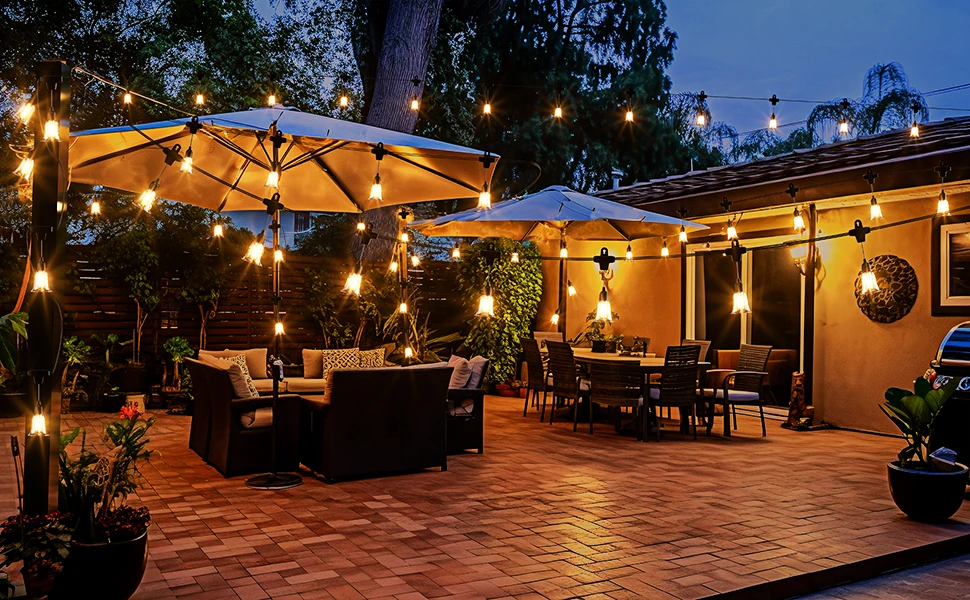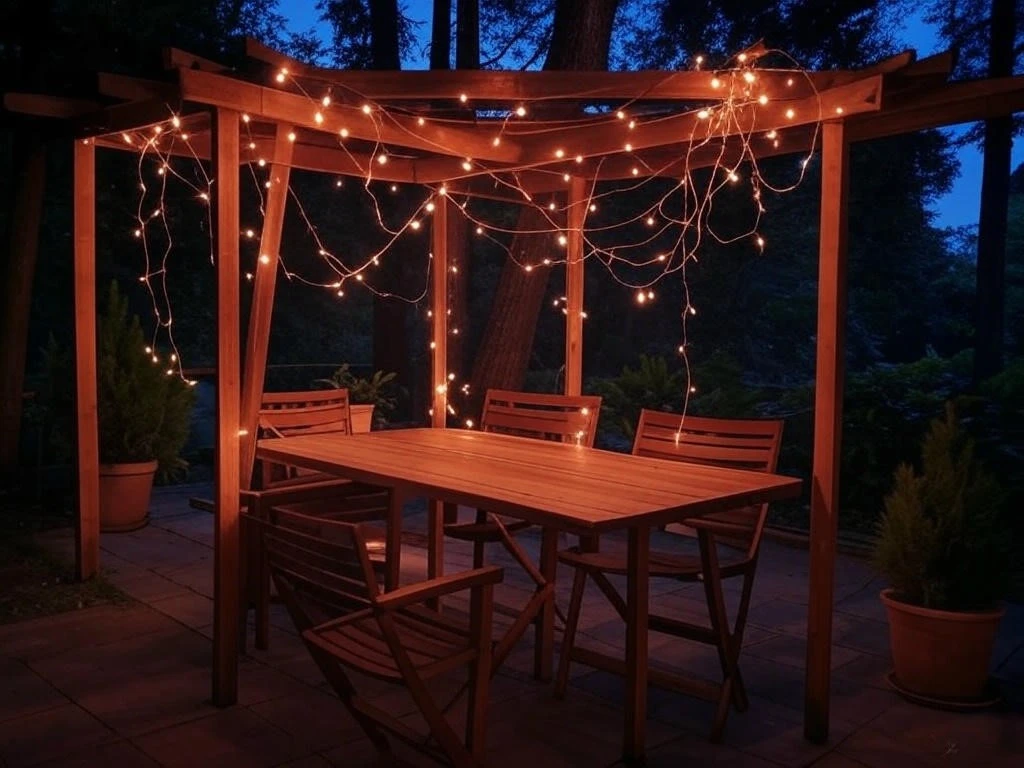String lights have become a staple for creating ambiance in gardens, patios, and indoor spaces. When choosing between solar string lights and battery-operated string lights, homeowners face a decision that balances cost, convenience, and environmental impact. This article compares the two options across key factors like energy efficiency, installation, maintenance, and versatility, helping you decide which is better for your outdoor lighting or indoor lighting needs. By exploring their strengths and limitations, we aim to provide a clear, practical guide for sustainable and effective lighting solutions.

How Solar String Lights Work
Solar string lights harness energy from the sun to power LED bulbs, offering an eco-friendly lighting option. They consist of:
- Solar panel: Converts sunlight into electricity via the photovoltaic effect.
- Rechargeable battery: Stores energy to power lights at night, typically using NiMH or lithium-ion batteries.
- LED bulbs: Energy-efficient lights that illuminate when activated.
- Photoreceptor: A sensor that turns lights on at dusk and off at dawn.
The solar panel charges the battery during the day, providing power for nighttime illumination without external electricity. This makes solar-powered string lights ideal for sustainable outdoor lighting, especially in sunny climates.
How Battery-Operated String Lights Work
Battery-operated string lights rely on disposable or rechargeable batteries (often AA or AAA) to power their LEDs. Key components include:
- Battery compartment: Houses the batteries and connects to the lighting circuit.
- LED bulbs: Similar to solar lights, they use energy-efficient LEDs.
- Switch or timer: Allows manual control or automated on/off cycles.
Unlike solar string lights, these lights don’t depend on sunlight, making them versatile for indoor string lighting or areas with limited sun exposure. However, they require regular battery replacements or recharging, which impacts cost and convenience.
Comparing Solar and Battery-Operated String Lights
To determine which is better, let’s compare solar string lights and battery-operated string lights across key criteria:
1. Energy Efficiency and Cost
Solar string lights are highly energy-efficient because they use renewable solar energy, eliminating electricity costs. Once purchased, they have minimal operating expenses, though initial costs can be higher due to the solar panel and rechargeable battery. However, battery life (1-3 years) and occasional replacements add to long-term costs.
Battery-operated string lights incur ongoing costs for battery replacements, especially if using disposable batteries. Rechargeable batteries reduce costs but require a charger and periodic maintenance. Over time, these expenses can surpass the cost of solar-powered string lights, especially for frequent use.
- Winner: Solar string lights for long-term energy efficiency and cost savings.
2. Installation and Placement Flexibility
Solar string lights require a solar panel placed in direct sunlight for 6-10 hours daily, limiting placement to sunny areas. Installation is simple, with no wiring needed, but the panel’s location can restrict design options. For example, indoor use is challenging unless the panel is near a window or a USB charging option is available.
Battery-operated string lights offer greater flexibility, as they don’t rely on sunlight. They can be used indoors, in shaded areas, or under dense foliage, making them ideal for indoor string lighting or temporary setups like events. However, battery compartments can be bulky, and wiring may need securing to prevent damage.
- Winner: Battery-operated string lights for placement versatility.
3. Environmental Impact
Solar string lights are a clear winner for eco-friendly lighting. By relying on renewable energy, they reduce carbon footprints and eliminate the need for grid electricity. However, battery disposal (if not rechargeable) and manufacturing impacts slightly offset their environmental benefits.
Battery-operated string lights have a higher environmental impact due to battery production and disposal. Disposable batteries contribute to waste, while rechargeable batteries require energy for charging, often from non-renewable sources. Choosing high-quality rechargeable batteries can mitigate this impact.
- Winner: Solar string lights for sustainable outdoor lighting.

4. Maintenance and Durability
Solar string lights require regular maintenance to ensure optimal performance. Cleaning the solar panel to remove dust or debris is essential, especially in dusty or snowy regions. The rechargeable battery needs replacement every 1-3 years, and exposure to harsh weather can damage wiring or LEDs. High-quality models with weather-resistant designs last longer.
Battery-operated string lights are low-maintenance in terms of power source, as batteries can be swapped quickly. However, frequent battery replacements (every few weeks for heavy use) can be inconvenient. Weather-resistant models are available, but outdoor use may still lead to corrosion or damage over time.
- Winner: Tie, depending on usage. Solar string lights require more panel maintenance, while battery-operated string lights need frequent battery changes.
5. Performance and Reliability
Solar string lights depend on sunlight availability. In cloudy regions or during winter, charging efficiency drops, leading to dimmer lights or shorter runtimes. A deep charge (turning lights off for 1-3 days) can help, but performance varies with weather. Some models offer USB charging as a backup, enhancing reliability.
Battery-operated string lights provide consistent performance, as long as batteries are charged or fresh. They’re unaffected by weather, making them reliable for indoor lighting or cloudy climates. However, forgetting to replace batteries can disrupt use, especially for timers or extended operation.
- Winner: Battery-operated string lights for consistent performance, especially in low-sunlight areas.
6. Aesthetic and Functional Versatility
Both types of string lights come in various designs, including fairy lights, globe lights, and lanterns, suitable for decorative or functional purposes. Solar string lights are often marketed for outdoor use, with weather-resistant features, while battery-operated string lights are popular for indoor string lighting, such as in bedrooms or event decor.
- Winner: Tie, as both offer diverse styles for outdoor lighting or indoor lighting.
Unique Applications for Each Type
- Solar string lights: Ideal for sustainable outdoor lighting, such as wrapping around trees, lining garden paths, or decorating pergolas. They can also be used indoors near windows or with USB charging for eco-conscious decor. For example, Bitpott’s solar string lights offer\title
System: solar string lights offer a sustainable solution for outdoor events, saving energy over time.
- Battery-operated string lights: Perfect for indoor holiday decorations or temporary setups where sunlight is limited, offering flexibility without reliance on weather conditions.
Practical Tips for Choosing and Maintaining String Lights
To maximize the value of your string lights, consider these tips:
- For solar string lights:
- Place the solar panel in direct sunlight and clean it regularly to ensure efficient charging.
- Use a deep charge (turn off for 36-72 hours) periodically to maintain battery health.
- Store lights indoors during extreme weather to protect the panel and wiring.
- Choose models with USB charging for cloudy days or indoor use.
- For battery-operated string lights:
- Opt for rechargeable batteries to reduce costs and environmental impact.
- Use a timer to extend battery life and automate operation.
- Check for weather-resistant models if using outdoors to prevent corrosion.
When to Choose Solar vs. Battery-Operated String Lights
- Choose solar string lights if:
- You want eco-friendly lighting with no ongoing energy costs.
- You have access to consistent direct sunlight for charging.
- You’re lighting large outdoor areas like gardens or patios for long-term use.
- Choose battery-operated string lights if:
- You need indoor string lighting or lighting in shaded areas.
- You prioritize consistent performance regardless of weather.
- You need portable, temporary lighting for events or seasonal decor.
Conclusion
Deciding between solar string lights and battery-operated string lights depends on your priorities. Solar-powered string lights excel in energy efficiency, environmental benefits, and long-term cost savings, making them ideal for sustainable outdoor lighting in sunny areas. Battery-operated string lights offer unmatched flexibility, reliability in low-sunlight conditions, and ease of use for indoor lighting or temporary setups. By considering factors like placement, maintenance, and environmental impact, you can choose the best string lights for your needs, ensuring beautiful, functional illumination for any space.

Comments